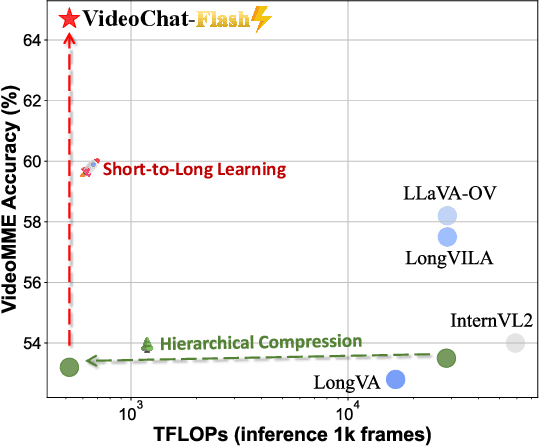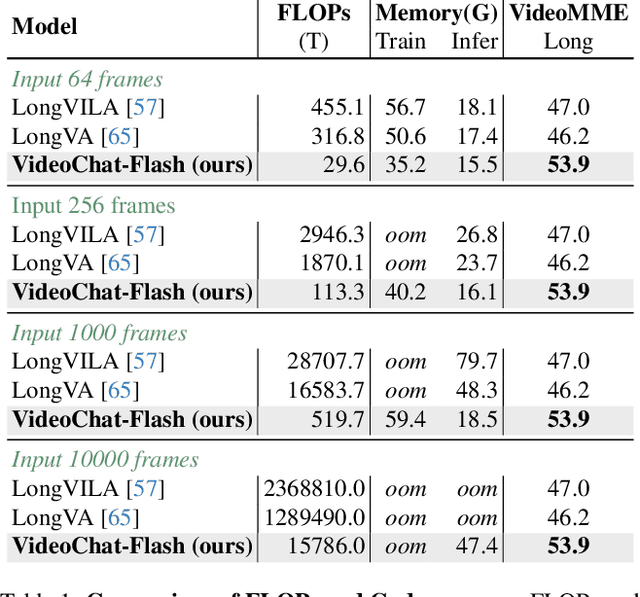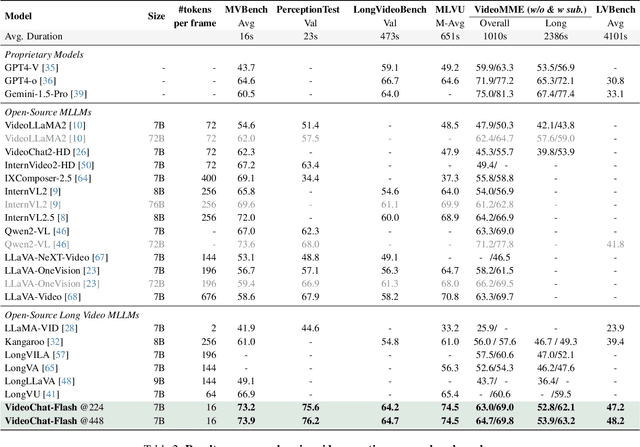Xinhao Li
Diving into Mitigating Hallucinations from a Vision Perspective for Large Vision-Language Models
Sep 17, 2025Abstract:Object hallucination in Large Vision-Language Models (LVLMs) significantly impedes their real-world applicability. As the primary component for accurately interpreting visual information, the choice of visual encoder is pivotal. We hypothesize that the diverse training paradigms employed by different visual encoders instill them with distinct inductive biases, which leads to their diverse hallucination performances. Existing benchmarks typically focus on coarse-grained hallucination detection and fail to capture the diverse hallucinations elaborated in our hypothesis. To systematically analyze these effects, we introduce VHBench-10, a comprehensive benchmark with approximately 10,000 samples for evaluating LVLMs across ten fine-grained hallucination categories. Our evaluations confirm encoders exhibit unique hallucination characteristics. Building on these insights and the suboptimality of simple feature fusion, we propose VisionWeaver, a novel Context-Aware Routing Network. It employs global visual features to generate routing signals, dynamically aggregating visual features from multiple specialized experts. Comprehensive experiments confirm the effectiveness of VisionWeaver in significantly reducing hallucinations and improving overall model performance.
VideoReasonBench: Can MLLMs Perform Vision-Centric Complex Video Reasoning?
May 29, 2025Abstract:Recent studies have shown that long chain-of-thought (CoT) reasoning can significantly enhance the performance of large language models (LLMs) on complex tasks. However, this benefit is yet to be demonstrated in the domain of video understanding, since most existing benchmarks lack the reasoning depth required to demonstrate the advantages of extended CoT chains. While recent efforts have proposed benchmarks aimed at video reasoning, the tasks are often knowledge-driven and do not rely heavily on visual content. To bridge this gap, we introduce VideoReasonBench, a benchmark designed to evaluate vision-centric, complex video reasoning. To ensure visual richness and high reasoning complexity, each video in VideoReasonBench depicts a sequence of fine-grained operations on a latent state that is only visible in part of the video. The questions evaluate three escalating levels of video reasoning skills: recalling observed visual information, inferring the content of latent states, and predicting information beyond the video. Under such task setting, models have to precisely recall multiple operations in the video, and perform step-by-step reasoning to get correct final answers for these questions. Using VideoReasonBench, we comprehensively evaluate 18 state-of-the-art multimodal LLMs (MLLMs), finding that most perform poorly on complex video reasoning, e.g., GPT-4o achieves only 6.9% accuracy, while the thinking-enhanced Gemini-2.5-Pro significantly outperforms others with 56.0% accuracy. Our investigations on "test-time scaling" further reveal that extended thinking budget, while offering none or minimal benefits on existing video benchmarks, is essential for improving the performance on VideoReasonBench.
VideoChat-R1: Enhancing Spatio-Temporal Perception via Reinforcement Fine-Tuning
Apr 10, 2025Abstract:Recent advancements in reinforcement learning have significantly advanced the reasoning capabilities of multimodal large language models (MLLMs). While approaches such as Group Relative Policy Optimization (GRPO) and rule-based reward mechanisms demonstrate promise in text and image domains, their application to video understanding remains limited. This paper presents a systematic exploration of Reinforcement Fine-Tuning (RFT) with GRPO for video MLLMs, aiming to enhance spatio-temporal perception while maintaining general capabilities. Our experiments reveal that RFT is highly data-efficient for task-specific improvements. Through multi-task RFT on spatio-temporal perception objectives with limited samples, we develop VideoChat-R1, a powerful video MLLM that achieves state-of-the-art performance on spatio-temporal perception tasks without sacrificing chat ability, while exhibiting emerging spatio-temporal reasoning abilities. Compared to Qwen2.5-VL-7B, VideoChat-R1 boosts performance several-fold in tasks like temporal grounding (+31.8) and object tracking (+31.2). Additionally, it significantly improves on general QA benchmarks such as VideoMME (+0.9), MVBench (+1.0), and Perception Test (+0.9). Our findings underscore the potential of RFT for specialized task enhancement of Video MLLMs. We hope our work offers valuable insights for future RL research in video MLLMs.
InternVideo2.5: Empowering Video MLLMs with Long and Rich Context Modeling
Jan 21, 2025Abstract:This paper aims to improve the performance of video multimodal large language models (MLLM) via long and rich context (LRC) modeling. As a result, we develop a new version of InternVideo2.5 with a focus on enhancing the original MLLMs' ability to perceive fine-grained details and capture long-form temporal structure in videos. Specifically, our approach incorporates dense vision task annotations into MLLMs using direct preference optimization and develops compact spatiotemporal representations through adaptive hierarchical token compression. Experimental results demonstrate this unique design of LRC greatly improves the results of video MLLM in mainstream video understanding benchmarks (short & long), enabling the MLLM to memorize significantly longer video inputs (at least 6x longer than the original), and master specialized vision capabilities like object tracking and segmentation. Our work highlights the importance of multimodal context richness (length and fineness) in empowering MLLM's innate abilites (focus and memory), providing new insights for future research on video MLLM. Code and models are available at https://github.com/OpenGVLab/InternVideo/tree/main/InternVideo2.5
VideoChat-Flash: Hierarchical Compression for Long-Context Video Modeling
Dec 31, 2024



Abstract:Long-context modeling is a critical capability for multimodal large language models (MLLMs), enabling them to process long-form contents with implicit memorization. Despite its advances, handling extremely long videos remains challenging due to the difficulty in maintaining crucial features over extended sequences. This paper introduces a Hierarchical visual token Compression (HiCo) method designed for high-fidelity representation and a practical context modeling system VideoChat-Flash tailored for multimodal long-sequence processing. HiCo capitalizes on the redundancy of visual information in long videos to compress long video context from the clip-level to the video-level, reducing the compute significantly while preserving essential details. VideoChat-Flash features a multi-stage short-to-long learning scheme, a rich dataset of real-world long videos named LongVid, and an upgraded "Needle-In-A-video-Haystack" (NIAH) for evaluating context capacities. In extensive experiments, VideoChat-Flash shows the leading performance on both mainstream long and short video benchmarks at the 7B model scale. It firstly gets 99.1% accuracy over 10,000 frames in NIAH among open-source models.
Fine-grained Video-Text Retrieval: A New Benchmark and Method
Dec 31, 2024Abstract:The ability of perceiving fine-grained spatial and temporal information is crucial for video-language retrieval. However, the existing video retrieval benchmarks, such as MSRVTT and MSVD, fail to efficiently evaluate the fine-grained retrieval ability of video-language models (VLMs) due to a lack of detailed annotations. To address this problem, we present FIBER, a FIne-grained BEnchmark for text to video Retrieval, containing 1,000 videos sourced from the FineAction dataset. Uniquely, our FIBER benchmark provides detailed human-annotated spatial annotations and temporal annotations for each video, making it possible to independently evaluate the spatial and temporal bias of VLMs on video retrieval task. Besides, we employ a text embedding method to unlock the capability of fine-grained video-language understanding of Multimodal Large Language Models (MLLMs). Surprisingly, the experiment results show that our Video Large Language Encoder (VLLE) performs comparably to CLIP-based models on traditional benchmarks and has a stronger capability of fine-grained representation with lower spatial-temporal bias. Project page: https://fiber-bench.github.io.
Online Video Understanding: A Comprehensive Benchmark and Memory-Augmented Method
Dec 31, 2024



Abstract:Multimodal Large Language Models (MLLMs) have shown significant progress in offline video understanding. However, applying these models to real-world scenarios, such as autonomous driving and human-computer interaction, presents unique challenges due to the need for real-time processing of continuous online video streams. To this end, this paper presents systematic efforts from three perspectives: evaluation benchmark, model architecture, and training strategy. First, we introduce OVBench, a comprehensive question-answering benchmark specifically designed to evaluate models' ability to perceive, memorize, and reason within online video contexts. It features six core task types across three temporal contexts-past, present, and future-forming 16 subtasks from diverse datasets. Second, we propose a new Pyramid Memory Bank (PMB) that effectively retains key spatiotemporal information in video streams. Third, we proposed an offline-to-online learning paradigm, designing an interleaved dialogue format for online video data and constructing an instruction-tuning dataset tailored for online video training. This framework led to the development of VideoChat-Online, a robust and efficient model for online video understanding. Despite the lower computational cost and higher efficiency, VideoChat-Online outperforms existing state-of-the-art offline and online models across popular offline video benchmarks and OVBench, demonstrating the effectiveness of our model architecture and training strategy.
Task Preference Optimization: Improving Multimodal Large Language Models with Vision Task Alignment
Dec 26, 2024Abstract:Current multimodal large language models (MLLMs) struggle with fine-grained or precise understanding of visuals though they give comprehensive perception and reasoning in a spectrum of vision applications. Recent studies either develop tool-using or unify specific visual tasks into the autoregressive framework, often at the expense of overall multimodal performance. To address this issue and enhance MLLMs with visual tasks in a scalable fashion, we propose Task Preference Optimization (TPO), a novel method that utilizes differentiable task preferences derived from typical fine-grained visual tasks. TPO introduces learnable task tokens that establish connections between multiple task-specific heads and the MLLM. By leveraging rich visual labels during training, TPO significantly enhances the MLLM's multimodal capabilities and task-specific performance. Through multi-task co-training within TPO, we observe synergistic benefits that elevate individual task performance beyond what is achievable through single-task training methodologies. Our instantiation of this approach with VideoChat and LLaVA demonstrates an overall 14.6% improvement in multimodal performance compared to baseline models. Additionally, MLLM-TPO demonstrates robust zero-shot capabilities across various tasks, performing comparably to state-of-the-art supervised models. The code will be released at https://github.com/OpenGVLab/TPO
Towards Open-Vocabulary Video Semantic Segmentation
Dec 12, 2024



Abstract:Semantic segmentation in videos has been a focal point of recent research. However, existing models encounter challenges when faced with unfamiliar categories. To address this, we introduce the Open Vocabulary Video Semantic Segmentation (OV-VSS) task, designed to accurately segment every pixel across a wide range of open-vocabulary categories, including those that are novel or previously unexplored. To enhance OV-VSS performance, we propose a robust baseline, OV2VSS, which integrates a spatial-temporal fusion module, allowing the model to utilize temporal relationships across consecutive frames. Additionally, we incorporate a random frame enhancement module, broadening the model's understanding of semantic context throughout the entire video sequence. Our approach also includes video text encoding, which strengthens the model's capability to interpret textual information within the video context. Comprehensive evaluations on benchmark datasets such as VSPW and Cityscapes highlight OV-VSS's zero-shot generalization capabilities, especially in handling novel categories. The results validate OV2VSS's effectiveness, demonstrating improved performance in semantic segmentation tasks across diverse video datasets.
TimeSuite: Improving MLLMs for Long Video Understanding via Grounded Tuning
Oct 25, 2024Abstract:Multimodal Large Language Models (MLLMs) have demonstrated impressive performance in short video understanding. However, understanding long-form videos still remains challenging for MLLMs. This paper proposes TimeSuite, a collection of new designs to adapt the existing short-form video MLLMs for long video understanding, including a simple yet efficient framework to process long video sequence, a high-quality video dataset for grounded tuning of MLLMs, and a carefully-designed instruction tuning task to explicitly incorporate the grounding supervision in the traditional QA format. Specifically, based on VideoChat, we propose our long-video MLLM, coined as VideoChat-T, by implementing a token shuffling to compress long video tokens and introducing Temporal Adaptive Position Encoding (TAPE) to enhance the temporal awareness of visual representation. Meanwhile, we introduce the TimePro, a comprehensive grounding-centric instruction tuning dataset composed of 9 tasks and 349k high-quality grounded annotations. Notably, we design a new instruction tuning task type, called Temporal Grounded Caption, to peform detailed video descriptions with the corresponding time stamps prediction. This explicit temporal location prediction will guide MLLM to correctly attend on the visual content when generating description, and thus reduce the hallucination risk caused by the LLMs. Experimental results demonstrate that our TimeSuite provides a successful solution to enhance the long video understanding capability of short-form MLLM, achieving improvement of 5.6% and 6.8% on the benchmarks of Egoschema and VideoMME, respectively. In addition, VideoChat-T exhibits robust zero-shot temporal grounding capabilities, significantly outperforming the existing state-of-the-art MLLMs. After fine-tuning, it performs on par with the traditional supervised expert models.
 Add to Chrome
Add to Chrome Add to Firefox
Add to Firefox Add to Edge
Add to Edge